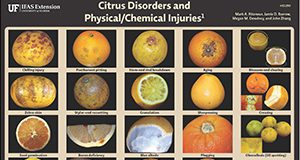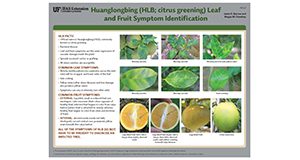Citrus canker is a non-systemic bacterial disease that affects citrus trees in both the citrus nursery and in commercial plantings. This poster is designed to assist citrus nursery workers in the identification of citrus canker. This one-page document was written by Jamie Burrow, Megan Dewdney, Ajia Paolillo, and Tim Riley and published by the UF/IFAS Plant Pathology Department.
http://edis.ifas.ufl.edu/pp346
Tag: Megan M. Dewdney
Citrus Fruit Blemishes and Decay Caused by Fungi and Bacteria
This new one-page citrus identification fact sheet illustrates different blemishes from fungi and bacteria that affect citrus. Written by Mark A. Ritenour, Jamie D. Burrow, Megan M. Dewdney, and John Zhang and published by the Horticultural Sciences Department.
http://edis.ifas.ufl.edu/hs1291
Florida Citrus Activity Book
The Florida Citrus Activity Book is a basic introduction to Florida citrus trees, diseases, and pests. This 20-page booklet is for elementary students. Written by J.D. Burrow, M.M. Dewdney, M.E. Rogers, and T. Vashisth and published by the Plant Pathology Department.
http://edis.ifas.ufl.edu/pp331
Huanglongbing (HLB; citrus greening) and Nutrient Deficiency Identification

Huanglongbing (HLB) is a bacterial disease that is spread by an insect, the Asian citrus psyllid. This two-page fact sheet, which is best viewed as a PDF, http://edis.ifas.ufl.edu/pdffiles/PP/PP32800.pdf, explains how to tell the difference between HLB symptoms and symptoms from nutrient deficiencies. Written by T. Vashisth, M.M. Dewdney, and J.D. Burrow and published by the Plant Pathology Department.
http://edis.ifas.ufl.edu/pp328
Huanglongbing (HLB; citrus greening) Leaf and Fruit Symptom Identification
Huanglongbing (HLB), commonly known as citrus greening, is a bacterial disease that affects all citrus varieties. This two-page fact sheet describes the leaf and fruit symptoms of HLB. Written by Jamie D. Burrow and Megan M. Dewdney and published by the Department of Plant Pathology.
http://edis.ifas.ufl.edu/pp327
Phytophtora Management in Citrus Nurseries
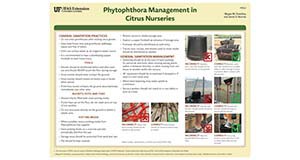
Check out the new fact sheet about Phytopthora Management in Citrus Nurseries. A great on-hand resource, this fact sheet covers sanitation practices, tools, and potting media for citrus nurseries. It also illustrates correct and incorrect practices and provides information about disinfectants and chemicals to use. Written by Megan M. Dewdney and Jamie D. Burrow, and published by the Plant Pathology Department.
http://edis.ifas.ufl.edu/pp322
Dooryard Citrus Production: Asiatic Citrus Canker Disease
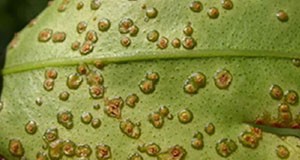
Asiatic citrus canker is a bacterial disease of citrus that causes necrotic lesions on leaves, stems, and fruit of infected trees. Severe cases can cause defoliation, premature fruit drop, twig dieback, and general tree decline.This eight-page fact sheet explains the history of citrus canker in Florida, describes the symptoms of citrus canker, and details how to manage the spread of citrus canker disease by preventing infection and controlling existing infections. Written by Megan M. Dewdney, Jamie D. Burrow, James H. Graham, Timothy M. Spann, and Ryan A. Atwood, and published by the Horticultural Sciences department.
http://edis.ifas.ufl.edu/pp323
Postbloom Fruit Drop (PFD) Identification and Management
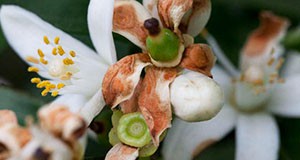
This two-sided ID card is idea for growers working in the field trying to identify or manage postbloom fruit drop (PFD) in citrus. The ID card includes photos of blooms affected by PFD and photos of healthy blooms for comparison. The card also includes facts and tips for managing PFD. Written by Megan M. Dewdney, Natalia A. Peres, and Jamie D. Burrow, and published by the UF Department of Plant Pathology, July 2015.
http://edis.ifas.ufl.edu/pp318
PP194/PP116 Homeowner Fact Sheet: Citrus Canker
Revised! PP194, a 4-page illustrated fact sheet by M.M. Dewdney, P.D. Roberts, J.H. Graham, K.R. Chung, and M. Zekri, informs homeowners about this serious disease of citrus, its history, symptoms, spread, and control strategies. Published by the UF Department of Plant Pathology, October 2009.
http://edis.ifas.ufl.edu/PP116
PP264 Exotic Diseases of Citrus Identification Sheet
PP264, a 2-page ID sheet by M.M. Dewdney, J.D. Yates, M.E. Rogers, and T.M. Spann, provides images for identification and comparison chart for Citrus Variegated Chlorosis (CVC), Leprosis, Citrus Black Spot, Sweet Orange Scab (SOS) and Citrus Tristeza Stem-Pitting (CTV-SP). Published by the UF Department of Plant Pathology, May 2009.
http://edis.ifas.ufl.edu/PP264
PP263 Citrus Greening, Blight and Tristeza Comparison Identification Sheet
PP263, a 2-page English/Spanish ID sheet by M.M. Dewdney, J.D. Yates, R.H. Brlansky, T.M. Spann, and M.E. Rogers, guides identification of Citrus Greening and provides a comparison chart for Citrus Greening, Blight and Tristeza. Published by the UF Department of Plant Pathology, May 2009.
http://edis.ifas.ufl.edu/PP263
CH199 Citrus Canker: An Established Infection in the Florida Citrus Industry
CH199, a full-color tri-fold brochure by J.D. Yates, T.M. Spann, M.E. Rogers, and M.M. Dewdney, provides key information on the history, spread, symptoms, and management of this serious disease affecting the citrus industry. Includes references and contact list. Published by the UF Department of Horticultural Sciences, July 2008.
http://edis.ifas.ufl.edu/CH199
CH198/CH198: Citrus Greening: A Serious Threat to the Florida Citrus Industry
CH198, a full-color tri-fold brochure by J.D. Yates, T.M. Spann, M.E. Rogers, and M.M. Dewdney, provides key information on the history, vector, symptoms, management, and diagnostics of this serious disease affecting the citrus industry. Includes references and contact list. Published by the UF Department of Horticultural Sciences, July 2008.
http://edis.ifas.ufl.edu/CH198

